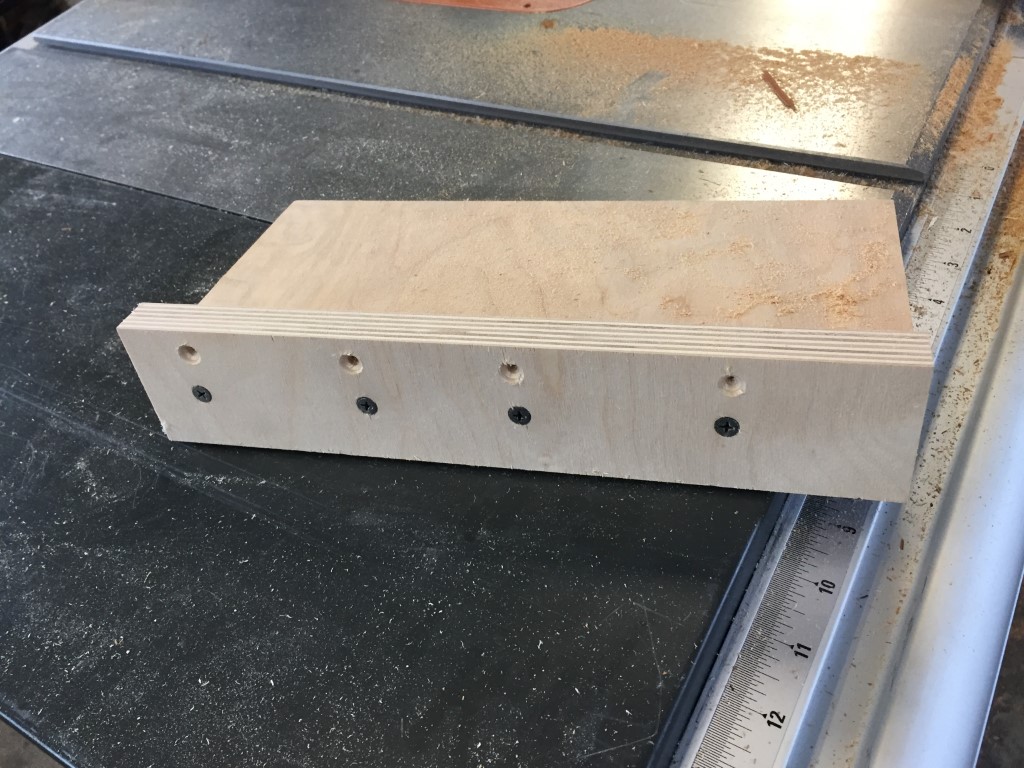This is a jig used for safely ripping thin boards on the table saw.
Normally, if you try to setup to make a cut too narrow, the fence will be too close to the blade (and guard) to make a safe cut with a normal push stick. This simple jig works to offset the fence to be out of the way and provides a built-in pushing mechanism well away from the saw blade.
The jig is made from 3/4" plywood, but it doesn’t need to be plywood. It may be preferable that the vertical portion isn’t plywood since 3/4" plywood isn’t exactly 3/4" thick. This can make calibration a bit more difficult. The vertical pieces are attached with drywall screws in countersunk holes - glue would also work. They could be a single longer board or more smaller ones like this. The horizontal piece should be wide enough to both give clearance for the clamps and make enough room for the push block and your fleshy bits. Mine is a bit narrow, but that’s the scrap I had on hand to work with. It’s best to make the width easy to setup. If you cut the base 9-1/4" wide then after adding the 3/4" wide mount on the right side, the total jig width is 10". You can then just add 10" to your target cut width when setting up your saw’s fence.
 This is a push block made from scrap 3/4" plywood. It doesn’t need to be plywood or even 3/4". That’s just the scrap I had handy. It just needs to be straight. The horizontal piece needs to be wide enough of a surface to keep your hand safely away from the saw blade. Glue is ideal and might be necessary to work on some saws (e.g. SawStop), but I just used drywall screws and recessed holes. I wasn’t paying enough attention and made the holes at the wrong height at first. The bottom of the vertical piece needs to hang down to match the height of the jig. In my case this is 3/4".
This is a push block made from scrap 3/4" plywood. It doesn’t need to be plywood or even 3/4". That’s just the scrap I had handy. It just needs to be straight. The horizontal piece needs to be wide enough of a surface to keep your hand safely away from the saw blade. Glue is ideal and might be necessary to work on some saws (e.g. SawStop), but I just used drywall screws and recessed holes. I wasn’t paying enough attention and made the holes at the wrong height at first. The bottom of the vertical piece needs to hang down to match the height of the jig. In my case this is 3/4".
 The push block rides on top of the jig. The board to be cut rides along the same edge that the push block rides against. The push block rides behind the board and your hand has a safe place on the right side.
The push block rides on top of the jig. The board to be cut rides along the same edge that the push block rides against. The push block rides behind the board and your hand has a safe place on the right side.
 I’m already uncomfortable enough without the blade guard on the saw. I’m not going to remove the pawls. This means my push block will stop at the release button for the pawls. That’s fine since that’s past the edge of the blade already anyway.
I’m already uncomfortable enough without the blade guard on the saw. I’m not going to remove the pawls. This means my push block will stop at the release button for the pawls. That’s fine since that’s past the edge of the blade already anyway.
